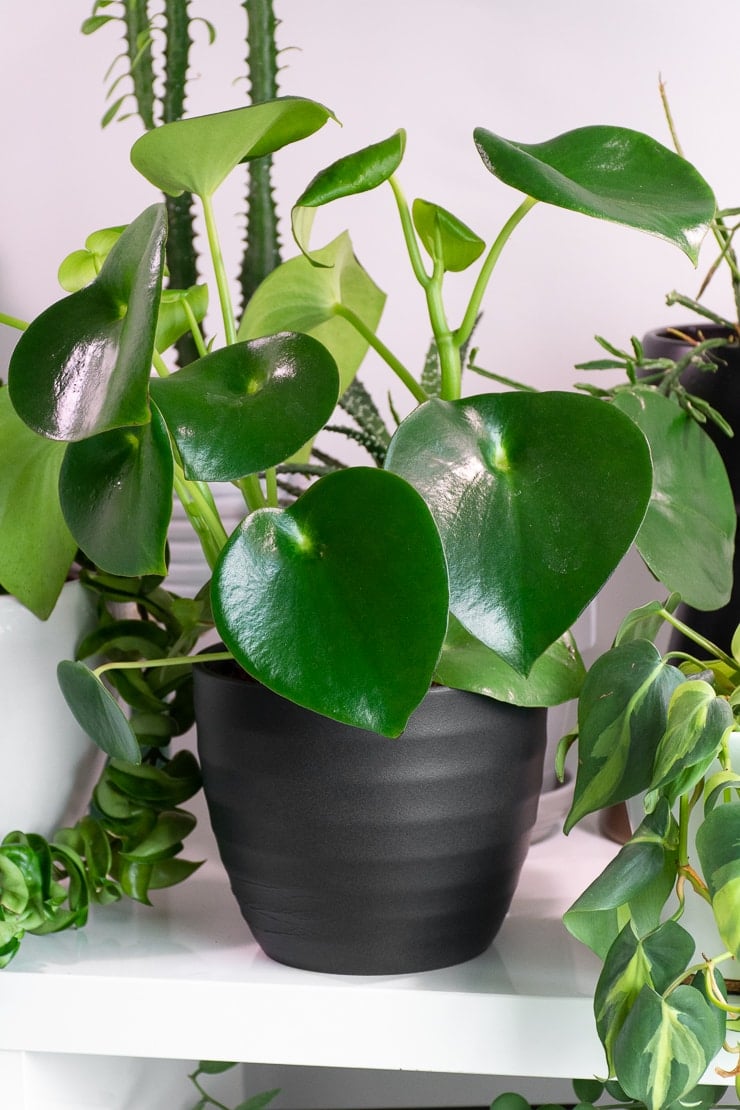Learn about peperomia raindrop, an easy plant to add to your collection.
All about peperomia raindrop care and propagation
Today we’re talking about Peperomia polybotrya, aka the peperomia raindrop and its large glossy, heart-shaped leaves. They aren’t difficult to care for and stay relatively compact, only growing to be about a foot tall. Their sturdy stems and fleshy leaves make them sound kind of like a succulent—they aren’t succulents, but their care is pretty similar to succulent care.

Peperomia raindrop care overview
- Peperomia raindrop (peperomia polybotrya) has glossy, heart-shaped leaves and sturdy stems.
- Grows to about a foot tall and is not a succulent, though its care is similar.
- Native to tropical regions of Central and South America.
- Prefers bright, indirect light and should be shielded from direct sunlight.
- Requires a well-draining soil mix; overwatering can lead to problems like edema and root rot.
- Thrives at room temperature (65-80°F); does not need high humidity, though it won’t hurt them.
- Propagate using stem cuttings.
- Often confused with Pilea peperomioides, but they belong to different plant families and are native to different continents.
Peperomia polybotrya background
There are thousands of species in the genus peperomia—polybotrya is just one. The genus peperomia is found all across the globe, including in South America, the Philippines, Australia, and parts of Africa like Madagascar. Most are small perennial epiphytes that grow on wood and rotting trees.
The peperomia raindrop specifically is native to tropical regions in Central and South America, namely Colombia and Peru. They prefer warm, shady, humid environments, and they have been cultivated in most tropical and subtropical regions in the world.
The name Peperomia polybotrya comes from the Greek language and translates directly to “resembling many peppers.” Other common names include the coin-leaf peperomia, coin plant, and even Chinese money plant, though that is usually more commonly used to refer to the pilea peperomioides (more on that next).

Peperomia raindrop vs. pilea peperomioides
I want to clarify something before we get rolling on the care guide. The peperomia raindrop and the pilea peperomioides (aka Chinese money plants) are not the same plant. They aren’t even really closely related, if you can believe it. Here’s the classification of each:
Piperales (order) > Piperaceae (family) > Peperomia (genus) > polybotrya (species)
Rosales (order) > Urticaceae (family) > Pilea (genus) > peperomioides (species)
They do belong to the same clades (angiosperms and tracheophytes), but those are really, really big groups. Like, one group down from the classification of “plantae kingdom.” The plantae kingdom is literally “plants.” So the biggest group you can get! The peperomia polybotrya also hails from Central and South America, while the pilea peperomioides comes from China.
Pilea peperomioides plants generally have a single main woody-looking stem and mother plant that grows up and sprouts new leaves from the top as it gets taller. The plant also sends runners out under the soil to produce baby plants, which are smaller versions of the mother plant. They can be chopped off and easily propagated, which is the reason this plant is often called the “pass it on plant.”
Peperomia raindrops, on the other hand, grow from thick stems and do not send out runners and reproduce like the pilea peperomioides plant does. But the big, showy leaves on each of these plants make them look pretty similar! Check it out, and then we’ll move along to caring for the raindrop.


How much light does a peperomia raindrop need?
One critical thing to remember about peperomia raindrop care is that it’s a hardy plant that doesn’t depend on direct sunlight. If you plan on growing it indoors, place it near a window with bright, indirect light for the best results. An east or west facing window is ideal throughout the year.
Avoid direct sunlight, especially in the summer, because it could scorch the leaves and cause discoloration. When grown outdoors, this plant should be placed in partial shade with no direct sunlight, especially if you live in a hot region. If your peperomia plant is not getting adequate light, you’ll notice the stems become leggy and it will grow slanted toward the light source.

What is the best soil?
A well-draining potting mix is crucial for all peperomia plants. They mimic succulents in many ways, including their sensitivity to overwatering. Therefore, a mix of coco coir or fine moss and perlite or sand is a good way to keep nutrients in and water out. Well-draining soil will prevent wilting and water-logging and keep your plant looking vibrant and healthy.
The raindrop peperomia stores a lot of water in its fleshy leaves and stems. Therefore, like succulents, they don’t need to be watered very often. You should allow the top half of the pot to dry out before watering thoroughly. This is generally about once a week during the growing season, depending on the humidity in the room.
If the lower leaves turn yellow or you notice the stems become leggy, you likely aren’t watering it often enough. If the pot feels heavy and waterlogged and the leaves wilt, you are likely overwatering it. Less is more with the raindrop.

Bumpy leaves on a peperomia polybotrya
Bumpy leaves on your peperomia polybotrya are caused by something called edema. It’s a disorder, which sounds a bit ominous, but don’t panic. It’s not contagious like bacteria or a virus, and it does not spread. Edema shows itself on the raindrop’s leaves via bumps or blister-looking growths.
Edema is caused by overwatering. These plants are very sensitive to overwatering, so when they get too much water, it builds up in the plant and causes parts of it to stretch and collapse. The bumps can later turn into a brown or brassy color and flatten out.
The affected leaves will not heal, but if the edema isn’t too bad, your plant can live just fine. As new healthy growth emerges, you can just trim off the bumpy leaves. If the edema is bad enough, the affected leaves will probably die off on their own. My plant has some bumpy leaves, and I’m not going to worry too much about it. He just got too much water at Home Depot. 🙂


Temperature & humidity
The optimal temperature range for the raindrop peperomia is 65 to 80 degrees Fahrenheit. They are best grown indoors because they prefer room temperature. They are very sensitive to low temperatures, so if you live in a region where it drops below 50 degrees at night or in the winter months, bring it indoors.
This plant also does not require misting or humidifiers to survive. This might be counterintuitive since they originate from extremely humid, tropical regions, but thanks to their succulent-like leaves that retain lots of water, they can withstand most humidity levels.
Indoor spaces typically have low humidity, but this plant will do just fine as long as you water it properly! In fact, if you mist your peperomia, it might lead to increased moisture on the surface of the pot’s soil. This could lead to fungus gnats moving in and laying eggs. No thank you.

Peperomia polybotrya propagation
Unlike some other peperomia propagation, peperomia polybotrya propagation takes a lot of patience. It will be about three months before you start to see shoots growing, and about eight months until it’s developed into a mature plant. There are two ways to propagate, either in water or soil.
The first step is to take a good cutting. Take a cutting that includes a growth point; these are the nodes on the plant stems that sprout new stems and leaves. Below is a closeup shot of a stem to show you what I mean.

Propagating peperomia raindrop in water
To propagate a peperomia raindrop in water, place the cutting in a jar of water and keep it away from direct light. Change the water every few days or so to keep the plant from rotting and to allow roots to sprout.
Once you can see roots growing, you can move the cutting into a pot with fresh soil. Choose a small container to prevent watering problems in the future. If you aren’t successful with water rooting due to rotting, you can try LECA propagation. I’ve really enjoyed experimenting with LECA propagation using snake plant leaves, which I have mixed success with in water.
Propagating peperomia raindrop in soil
Propagating peperomia raindrop in soil requires a bit more work. First, prepare a cutting like you would if you were water propagating. This time, however, dip it in rooting hormone and insert that end into the soil (choose a small pot for this as well).
Rooting hormone requires high humidity levels to grow, so cover the top of the pot with plastic wrap or a clear plastic bag to increase humidity. Keep the pot away from direct sunlight and heat. Once roots have developed, you may remove the plastic covering. To check if roots have developed, tug very gently on the plant. If there is resistance, roots have sprouted! Continue caring for it until new growth emerges.

In conclusion…
The Peperomia raindrop is a delightful and easy houseplant, perfect for adding a bit of greenery to most spaces in your home. Its unique, heart-shaped leaves and compact growth make it an ideal choice for plant enthusiasts and beginners alike.
Remember, it thrives in bright, indirect light and requires well-draining soil to prevent overwatering issues. Have you tried growing a raindrop in your home? Share your experiences and tips in the comments below…happy planting!
Pin my tips!


Brittany is a seasoned DIY home and garden expert, running a creative brand since 2014 that inspires others with approachable plant care guides, woodworking tutorials, and decor projects. She is a certified project manager and has completed extensive coursework in the art and science of growing your own plants. Her work has been recognized by major publications, and she routinely collaborates with fellow DIY industry leaders—but her favorite thing to do is inspire you! Learn more about her here.

Leave a comment